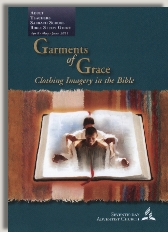|
||||||||||||||
Commentary on "More Clothing Imagery"
Day 2: Sunday, June 12, 2011 - "Who Touched My Clothes?"
OVERVIEW
Today’s lesson reviews Mark 5:24-34 and Luke 8:43-48. This is the story of the woman who had a bleeding problem for 12 years. She had gone to many doctors, but her condition had only worsened.
OBSERVATIONS
The story is pretty straight-forward. I enjoyed the writer’s sentence, “This woman had a great deal of faith in Jesus, enough to believe if she could touch even His clothes, she would be healed. Of course, it wasn’t the clothes themselves that healed her—not even the touch. It was only the power of God working in someone who, out of desperation, came to the Lord in faith, aware of her own helplessness and need.”
Just as a bit of background, I’d like to mention the following regarding the hem (or tassel, “tzitziyot” in Hebrew) of a garment. In Numbers 15:37-41 God gives the instructions to the Israelites regarding their garments:
“The Lord said to Moses, ‘Speak to the Israelites and say to them: throughout the generations to come, you are to make tassels on the corners of one’s garments, with a blue cord on each tassel. You will have these tassels to look at and so will remember all the commands of the Lord, that you may obey them and not prostitute yourselves by going after the lusts of your own hearts and eyes. Then you will remember to obey all My commands, and will be consecrated to your God. I am the Lord your God.”
These tassels were a constant reminder to walk according to God’s laws and His Word. These tassels also came to be associated with a person’s authority. The story in 1 Samuel 24:4-6 is such an example. In the case of King Saul, we find that David humiliated him by sneaking up to him in a cave and cutting off his (Saul’s) tassel. Similarly, when Ruth asked Boaz to spread the corner of his garment over her, it was a symbolic way of saying she was placing herself under his authority (Ruth 3:8-9). With so much symbolism attached to the hem/tassel of the garment, this woman’s rationale for touching His hem is understandable.
I really like the account of this woman’s story as it’s told in Matthew 9:20-22:
“Just then a woman, who had been subject to bleeding for twelve years, came up behind Him and touched the hem of His garment; for she said to herself, ‘If I only touch His cloak, I will be healed.’ Jesus turned and saw her. ‘Take heart, daughter,’ He said, ‘your faith has healed you.’ And the woman was healed from that moment.”
Jesus makes the point of having the woman verbalize her need and then reiterating that it was her faith that healed her. It wasn’t the hem or tassel. Jesus knew her heart and that her faith was strong.
I would like to clarify a sentence used by the writer in this lesson as it can have a different meaning within the Adventist community: “Her touching His clothes was faith revealed in works, which is what Christianity is all about.”
Christianity is all about the gospel and the saving work of our Lord Jesus Christ.
“For I am not ashamed of the gospel, because it is God’s power for salvation to everyone who believes, first to the Jew, and also to the Greek. For in it God’s righteousness is revealed from faith to faith, just as it is written: ‘The righteous will live by faith’.” (Rom. 1:16, 17)
It’s true that faith without works is dead (James 2:17), but works are an outpouring/natural response to what Christ has already done—past tense. Not in any way is it part of the salvation equation (Eph. 2:8, 9). Here are two examples of how people perceive salvation:
Correct:
Faith in Christ = Salvation + Good Works
Incorrect:
Faith in Christ + Good Works = Salvation
Christians will do good works, not because they must do so to gain salvation, but because it has become their new nature to do good works. Ellen G. White said in Testimonies for the Church, Vol. 2, p. 122:
“If we live a life of perfect obedience, His promises will be fulfilled toward us.”
This is a sample of how she emphasized works as necessary for salvation. His promises are somehow linked to our performance. Eph. 2:8-10 tells us differently:
“For by grace you are saved through faith, and this is not from yourselves; it is God’s gift—not from works, so that no one can boast. For we are His creation—created in Christ Jesus for good works, which God prepared ahead of time so that we should walk in them.”
As Jesus said to her, it was this woman’s faith that made her well. By publically stating that she had touched His garment; her faith became known and could be used to glorify God and to witness to others. While this woman was healed by her faith, many others aren’t healed. We need to come to the point of complete submission to Him no matter what the outcome. Faith isn’t a matter of “name it and claim it”. It doesn’t override God’s sovereignty. Lack of healing cannot be blamed on insufficient faith, and neither can it always be attributed to specific sin (see Paul’s story in 2 Cor. 12:7-10). As believers, we have the hope and assurance of eternal life, no matter what this life holds (John 3:16).
CONCLUSIONS
- The author is correct in saying that the woman came in complete faith, and that her healing had nothing specifically to do with the clothes.
- Christianity is all about the gospel and the saving work of our Lord Jesus Christ resulting in good works (Eph. 2:8-10)
- Real faith is not “name it and claim it”. Lack of healing cannot be blamed on insufficient faith (2 Cor. 12:7-10).
- We have to accept and surrender to God’s sovereignty and His will, not ours. We have to trust completely in Him regardless of the outcome.
- As believers, we have the hope and assurance of eternal life (John 3:16). No matter what this life holds, we have a better hope (2 Cor. 5:1).
(Emphasis supplied in all passages.)
Copyright 2011 BibleStudiesForAdventists.com. All rights reserved. Revised June 11, 2011. This website is published by Life Assurance Ministries, Glendale, Arizona, USA, the publisher of Proclamation! Magazine. Contact email: BibleStudiesForAdventists@gmail.com.
The Sabbath School Bible Study Guide and the corresponding E.G. White Notes are published by Pacific Press Publishing Association, which is owned and operated by the Seventh-day Adventist church. The current quarter's editions are pictured above.
Official Adventist Resources
Standard Edition Study Guide Week 12
Teacher's Edition Study Guide Week 12
Easy Reading Edition Study Guide Wk 12
Search the Complete Published Ellen G. White Writings
Please Support This Project


